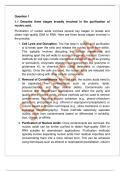Question 1
1.1 Describe three stages broadly involved in the purification of
nucleic acid.
Purification of nucleic acids involves several key stages to isolate and
obtain high-quality DNA or RNA. Here are three broad stages involved in
the process:
1. Cell Lysis and Disruption: The first step in nucleic acid purification
is to break open the cells and release the nucleic acids from within.
This typically involves disrupting the cellular membranes and
breaking apart the cell walls to access the genetic material. Common
methods for cell lysis include mechanical disruption (such as grinding
or sonication), enzymatic digestion (using enzymes like lysozyme or
proteinase K), or chemical lysis (using detergents or chaotropic
agents). Once the cells are lysed, the nucleic acids are released into
the solution along with other cellular components.
2. Removal of Contaminants: After cell lysis, the nucleic acids need to
be separated from contaminants such as proteins, lipids,
polysaccharides, and other cellular debris. Contaminants can
interfere with downstream applications and affect the purity and
quality of the nucleic acids. Various methods can be used to remove
contaminants, including organic extraction (e.g., phenol-chloroform
extraction), precipitation (e.g., ethanol or isopropanol precipitation), or
column-based purification techniques (e.g., silica membrane or anion
exchange chromatography). These methods selectively separate
nucleic acids from contaminants based on differences in solubility,
size, charge, or affinity.
3. Purification of Nucleic Acids: Once contaminants are removed, the
nucleic acids can be further purified to obtain high-quality DNA or
RNA suitable for downstream applications. Purification methods
typically involve separating nucleic acids from residual impurities and
concentrating them into a more refined form. This can be achieved
using techniques such as ethanol or isopropanol precipitation, column
, chromatography (e.g., gel filtration or affinity chromatography), or
electrophoresis (e.g., agarose gel electrophoresis or polyacrylamide
gel electrophoresis). These methods allow for the isolation of nucleic
acids based on factors such as size, charge, sequence, or binding
affinity, resulting in purified DNA or RNA samples ready for use in
molecular biology experiments.
These three stages—cell lysis and disruption, removal of contaminants,
and purification of nucleic acids—are fundamental steps in the process of
isolating and purifying nucleic acids from biological samples. The choice of
specific methods and techniques within each stage depends on the type of
sample, the desired purity and yield of nucleic acids, and the intended
downstream applications.
1.2 Define
1.2.1 Constitutive genes
These are genes that are continuously expressed in all cells of an
organism at a relatively constant level, regardless of environmental
conditions or developmental stage. Constitutive genes typically
encode essential cellular functions or housekeeping processes
necessary for basic cellular metabolism and maintenance. Examples
of constitutive genes include those involved in fundamental processes
like DNA replication, transcription, translation, and energy
metabolism.
1.2.2 DNA polymerase III
DNA polymerase III is a key enzyme involved in DNA replication in
prokaryotic cells, such as bacteria. It synthesizes new DNA strands by
adding nucleotides to the growing DNA chain during replication. DNA
polymerase III is highly processive, meaning it can add many
nucleotides sequentially without dissociating from the DNA template. It
also possesses proofreading activity to correct errors that may occur
during DNA synthesis, ensuring high fidelity replication.
,1.2.3 Nucleotide excision repair
Nucleotide excision repair (NER) is a DNA repair mechanism that
removes a wide range of DNA lesions, including bulky adducts,
thymine dimers, and other types of DNA damage caused by exposure
to UV radiation, chemical mutagens, or environmental toxins. NER
operates by recognizing and excising damaged nucleotides from the
DNA strand, followed by resynthesis of the excised region using the
complementary DNA strand as a template. This repair process helps
maintain the integrity of the genome and prevent mutations and
genomic instability.
1.2.4 Helicase
Helicases are enzymes that unwind the double-stranded DNA
molecule by breaking the hydrogen bonds between the
complementary base pairs, separating the two strands and allowing
access to the genetic information encoded in the DNA. Helicases play
crucial roles in various DNA metabolic processes, including DNA
replication, repair, recombination, and transcription. They utilize the
energy from ATP hydrolysis to power the unwinding of the DNA
double helix, making the DNA accessible to other enzymes and
proteins involved in these processes.
1.2.5 Transposable element
Transposable elements, also known as transposons or jumping genes, are
DNA sequences that have the ability to move or transpose within the genome
of an organism. They can change their positions within the genome either by
a cut-and-paste mechanism or a copy-and-paste mechanism. Transposable
elements can have significant impacts on genome structure, evolution, and
gene expression regulation. They may disrupt genes or regulatory
sequences when they insert into new genomic locations, leading to genetic
variation and potentially influencing phenotypic traits.
, Question 2
2.1Describe the series of steps that are involved in the formation of
DNA/RNA chain.
• Initiation: The process begins with the recognition of a specific
sequence on the DNA template called the promoter by RNA
polymerase. In prokaryotes, initiation involves the binding of RNA
polymerase to the promoter sequence, while in eukaryotes, initiation
requires the assembly of transcription factors and RNA polymerase at
the promoter.
• Elongation: Once RNA polymerase is bound to the promoter, it
unwinds the DNA double helix and begins synthesizing the RNA
molecule by adding complementary ribonucleotides (A, U, C, G for
RNA; A, T, C, G for DNA) to the growing RNA chain, following the
template DNA strand in a 5' to 3' direction.
• Termination: Transcription continues until a termination signal is
reached, which causes RNA polymerase to dissociate from the DNA
template, releasing the newly synthesized RNA molecule. In
prokaryotes, termination signals often involve specific DNA sequences
that form hairpin loops in the RNA transcript, while in eukaryotes,
termination is more complex and involves the recognition of
polyadenylation signals and cleavage of the RNA transcript.
2.2 You are characterizing the genome of a newly isolated virus to
determine whether it is composed of DNA or RNA. After utilizing
nucleases to entirely degrade the sample to its constituent nucleotides,
you determine the approximate relative proportions of nucleotides. The
results of your assay are as follows:
0% dGTP 20% CTP 0% dCTP 29% GTP 0% dTTP 18% UTP 0% ATP 33% ATP
What can you conclude about the composition of the viral genome?
• The results indicate the relative proportions of nucleotides in the viral
genome.





